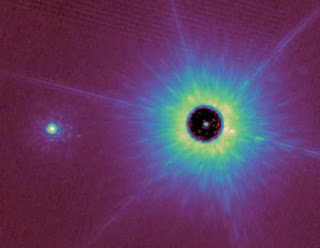M Class stars, or Red Dwarfs, are the most abundant stars in the Galaxy, and presumably the Universe. They are small (7.5-60% of the mass of the Sun) and cool (2300-3800 K, compared to 5778 K for our Sun), but can be very long-lived, as they burn their fuel slowly. Since they are the most abundant stars, it is also likely that the majority of planets in the Galaxy orbit Red Dwarfs, making them interesting to scientists studying planets in other stellar systems. It has been demonstrated that smaller stars are less likely to host Hot-Jupiter type planets, but apart from this there do not seem to be any less objects in any other categories orbiting these stars.
In theory a large object orbiting a small (and therefore dim) star at a distance should be detectable by direct imaging; this is in contrast to other planet detection methods, which favor the detection of objects close to their host stars. The Planets Around Low-Mass Stars (PALMS) survey aims to detect such planets using direct observation from Earth-based observatories. In a paper published in the arXiv online database at Cornell University Library on 9 May 2012, and accepted for publication in The Astrophysics Journal, a team of scientist led by Brendan Bowler of the Institute for Astronomy at the University of Hawai‘i describe the discovery of the first object by the PALMS survey, a Brown Dwarf (an object too small to be a star but too large to be considered a planet) orbiting the Red Dwarf 1RXS J235133.3+312720, directly imaged from the Keck-II Telescope.
1RXS J2355133.3+312720 and its companion. The star is behind a translucent coronagraph. Bowler et al. (2012).
1RXS J235133.3+312720 is about 160 light years from Earth; it has about 45% of the Sun's mass, and an effective surface temperature of about 3520 K. It is thought to be a fairly young object by stellar standards, probably less than 150 million years old, and certainly no more than 500 million years old. The Brown Dwarf obits it at a a distance of 119 AU, and has a mass equivalent to 32 times that of Jupiter. While this is considerably too large to be considered a planet, it does prove that the PALMS survey methodology works in principle.
See also The object orbiting GD66 is probably a planet, not a Brown Dwarf, KOI-13b, a big, hot planet not a Brown Dwarf, KOI-96, a mini planetary system with a star not much bigger than Jupiter, Third body in the AV Canis Minoris system and Stars on Sciency Thoughts YouTube.
Follow Sciency Thoughts on Facebook.

